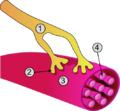Muscle cell
Muscle cell
A muscle cell, also known as a myocyte, is a type of cell that makes up muscle tissue. There are three types of muscle cells in the human body: skeletal, cardiac, and smooth muscle cells. Each type has a unique structure and function.
Structure[edit]
Muscle cells are elongated and are packed with myofibrils, which are bundles of protein filaments that play a key role in muscle contraction. The cell's cytoplasm, known as the sarcoplasm, contains numerous mitochondria to meet the energy demands of the cell.
Skeletal muscle cells[edit]
Skeletal muscle cells, also known as muscle fibers, are long, cylindrical cells that contain multiple nuclei. They are surrounded by a plasma membrane called the sarcolemma, which helps transmit signals from the nervous system.
Cardiac muscle cells[edit]
Cardiac muscle cells, or cardiomyocytes, are shorter and branched, with one or two centrally located nuclei. They are connected by intercalated discs, which allow electrical signals to pass between cells, coordinating their contraction.
Smooth muscle cells[edit]
Smooth muscle cells are spindle-shaped and contain a single nucleus. Unlike skeletal and cardiac muscle cells, they do not have striations.
Function[edit]
Muscle cells are responsible for producing force and motion. They do this by contracting in response to electrical signals from the nervous system.
Skeletal muscle cells[edit]
Skeletal muscle cells contract to move the bones of the skeleton. They are under voluntary control, meaning we can consciously control their contraction.
Cardiac muscle cells[edit]
Cardiac muscle cells contract to pump blood throughout the body. They are under involuntary control, meaning their contraction is not consciously controlled.
Smooth muscle cells[edit]
Smooth muscle cells contract to move substances through the body's organs, such as food through the digestive tract or blood through the blood vessels. They are also under involuntary control.
See also[edit]
Ad. Transform your life with W8MD's Budget GLP-1 injections from $75


W8MD offers a medical weight loss program to lose weight in Philadelphia. Our physician-supervised medical weight loss provides:
- Weight loss injections in NYC (generic and brand names):
- Zepbound / Mounjaro, Wegovy / Ozempic, Saxenda
- Most insurances accepted or discounted self-pay rates. We will obtain insurance prior authorizations if needed.
- Generic GLP1 weight loss injections from $75 for the starting dose.
- Also offer prescription weight loss medications including Phentermine, Qsymia, Diethylpropion, Contrave etc.
NYC weight loss doctor appointmentsNYC weight loss doctor appointments
Start your NYC weight loss journey today at our NYC medical weight loss and Philadelphia medical weight loss clinics.
- Call 718-946-5500 to lose weight in NYC or for medical weight loss in Philadelphia 215-676-2334.
- Tags:NYC medical weight loss, Philadelphia lose weight Zepbound NYC, Budget GLP1 weight loss injections, Wegovy Philadelphia, Wegovy NYC, Philadelphia medical weight loss, Brookly weight loss and Wegovy NYC
|
WikiMD's Wellness Encyclopedia |
| Let Food Be Thy Medicine Medicine Thy Food - Hippocrates |
Medical Disclaimer: WikiMD is not a substitute for professional medical advice. The information on WikiMD is provided as an information resource only, may be incorrect, outdated or misleading, and is not to be used or relied on for any diagnostic or treatment purposes. Please consult your health care provider before making any healthcare decisions or for guidance about a specific medical condition. WikiMD expressly disclaims responsibility, and shall have no liability, for any damages, loss, injury, or liability whatsoever suffered as a result of your reliance on the information contained in this site. By visiting this site you agree to the foregoing terms and conditions, which may from time to time be changed or supplemented by WikiMD. If you do not agree to the foregoing terms and conditions, you should not enter or use this site. See full disclaimer.
Credits:Most images are courtesy of Wikimedia commons, and templates, categories Wikipedia, licensed under CC BY SA or similar.
Translate this page: - East Asian
中文,
日本,
한국어,
South Asian
हिन्दी,
தமிழ்,
తెలుగు,
Urdu,
ಕನ್ನಡ,
Southeast Asian
Indonesian,
Vietnamese,
Thai,
မြန်မာဘာသာ,
বাংলা
European
español,
Deutsch,
français,
Greek,
português do Brasil,
polski,
română,
русский,
Nederlands,
norsk,
svenska,
suomi,
Italian
Middle Eastern & African
عربى,
Turkish,
Persian,
Hebrew,
Afrikaans,
isiZulu,
Kiswahili,
Other
Bulgarian,
Hungarian,
Czech,
Swedish,
മലയാളം,
मराठी,
ਪੰਜਾਬੀ,
ગુજરાતી,
Portuguese,
Ukrainian




